

Also Droschel (? German), vrai reseau (French) and bobbin mesh. See also Mechlin ground.

This is traditionally worked without pins, which can be tricky. There are several half stitches to be tightened, and it is useful to have a pin to tighten against. However, the pin must not be in the centre of the stitch, as this might cause a hole.

So I put the pin first, so the stitch can be tightened against it. It still needs careful tightening, to make sure that the mini-plait does not end up lop-sided. As you can see from the photo, I was not always sucessful! See pattern 307.
Working: pin, 4 half stitches, twist both pairs.
I have not provided an animation for this stitch. These old grounds are fairly similar to each other. They are important for lace history identification, and of course if you want to make lace within a specific lace tradition, then you have to use the correct ground. However, these are not my lace traditions, so I am just describing them for completeness. I would advise that you learn simpler grounds before trying this, for example, double Torchon ground. Once you've done that, you won't need an animation!There are other possibilities for the pin. Using no pin is, of course, the tradition method. Another way is to put the pin aferwards, as in Mechlin ground. I found this tended to squash up the plait too much, as it is longer than Mechin ground. One authority said that you should put pins before and after the plait, which seems excessive! But feel free to do so, if you choose. The most sensible place might be to put the pin in the middle of the stitch. That is easiest, but it does leave a hole, as I mention above. "A Lace Guide for Makers and Collectors" by Gertrude Whiting (1920) describes Brussels ground in two versions, one fait sans epingles (made without pins) and one made with pins, which she describes as "in the hands of amatuers at least, much more regular and pleasing than when pins are not employed". However, this makes the ground into double Torchon ground.
Some authorities describe Mechlin ground as having 4 half stitches (rather than 3). Still there seems to be a feeling that Mechlin ground has a shorter plait (less half stitches) than Brussels plait, so possibly there are variants of Brussels ground which have more than 4 half stitches in the plait. There may also be different numbers of twists between the stitches. I am not an expert on all this!
© Jo Edkins 2017 - return to lace index